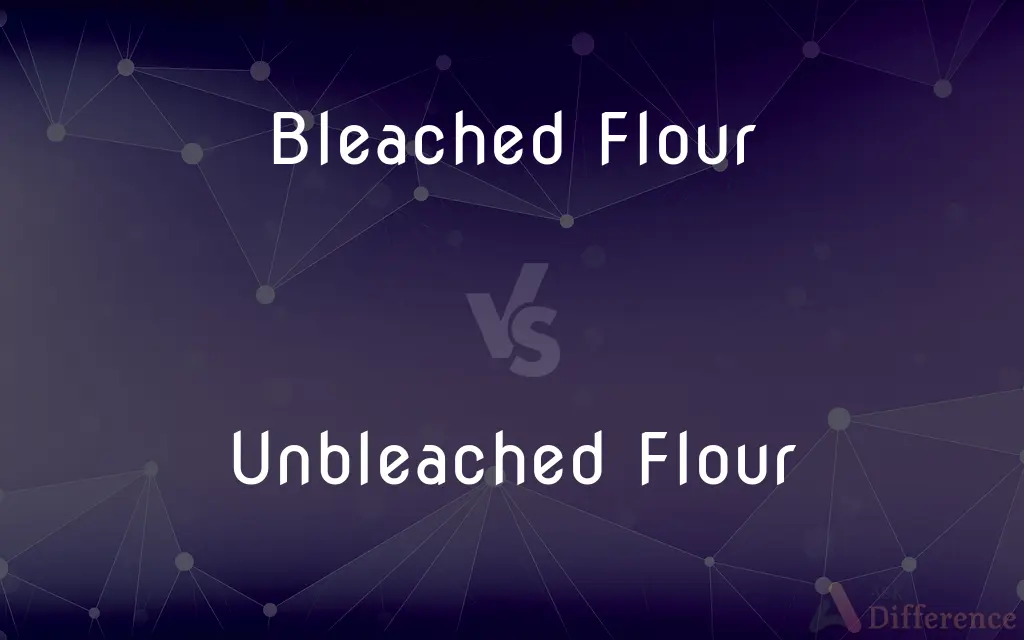Bleached Flour vs. Unbleached Flour — What's the Difference?
By Tayyaba Rehman & Urooj Arif — Published on February 13, 2024
Bleached flour is chemically treated to whiten and soften, while unbleached flour naturally ages to a creamy color and has a denser texture.

Difference Between Bleached Flour and Unbleached Flour
Table of Contents
ADVERTISEMENT
Key Differences
Bleached Flour and Unbleached Flour are two common types of wheat flour used in baking, distinguished by their processing methods and resulting characteristics. Bleached flour undergoes a chemical treatment with bleaching agents to hasten the aging process, resulting in a whiter color and finer grain. This process also alters the flour's protein structure, affecting its gluten-forming ability and making it suitable for a wide range of baked goods, particularly those requiring a tender texture, such as cakes and pastries.
Unbleached Flour, on the other hand, is allowed to age naturally after milling, which can take several months. This natural aging process results in a flour that is less white, typically off-white or creamy in color, and has a slightly denser texture compared to bleached flour. The absence of bleaching agents means that unbleached flour retains more of its natural wheat flavor and nutrients, making it a preferred choice for many health-conscious consumers and professional bakers.
The choice between bleached and unbleached flour often depends on the desired outcome of the baked good. Bleached flour's finer texture and altered protein structure make it well-suited for recipes that require a light, airy texture, while unbleached flour's higher protein content and denser texture are ideal for breads and other baked goods that benefit from a chewier structure and more robust flavor.
In terms of nutritional content, both bleached and unbleached flour are similar in calories and macronutrients, but the bleaching process can affect the vitamin content slightly, with unbleached flour typically having a slight nutritional edge. Additionally, some consumers prefer unbleached flour due to concerns over the chemical residues from the bleaching agents, although these are generally considered safe in the amounts used.
Overall, the choice between bleached and unbleached flour largely comes down to personal preference, the specific requirements of the recipe, and considerations regarding the processing chemicals. Both types of flour play vital roles in baking, each bringing distinct qualities to a wide variety of baked goods.
ADVERTISEMENT
Comparison Chart
Color
Whiter due to chemical treatment
Creamy or off-white, naturally aged
Texture
Finer, softer grain
Slightly denser texture
Processing
Treated with bleaching agents
Naturally aged, no chemical bleaching
Best Used For
Tender baked goods like cakes and pastries
Breads and baked goods needing structure
Nutritional Difference
Slightly lower in some vitamins due to bleaching
Retains more natural nutrients
Compare with Definitions
Bleached Flour
Has a finer, softer texture ideal for tender baked goods.
Bleached flour gave my cookies the perfect tender texture.
Unbleached Flour
Flour that naturally ages to a creamy color without chemicals.
I prefer unbleached flour for its natural aging process.
Bleached Flour
Less favored by health-conscious consumers due to chemicals.
Despite its use in baking, some avoid bleached flour due to its chemical treatment.
Unbleached Flour
Retains more natural wheat flavor and nutrients.
The unbleached flour added a rich flavor to my pie crust.
Bleached Flour
Flour chemically treated to speed up aging and whiten.
I used bleached flour to ensure my cake had a delicate crumb.
Unbleached Flour
Considered a healthier option compared to bleached flour.
For a healthier choice, I bake with unbleached flour.
Bleached Flour
Suitable for recipes requiring a light, airy texture.
For airy pancakes, I always choose bleached flour.
Unbleached Flour
Gains strength over time, making it suitable for yeast breads.
My artisan breads turn out best with unbleached flour.
Bleached Flour
Whiter in color due to chemical processing.
The bleached flour's whiteness made my bread visually appealing.
Unbleached Flour
Denser texture, ideal for breads and chewy baked goods.
Unbleached flour gives my bread a robust structure.
Common Curiosities
Is unbleached flour healthier?
Slightly, due to less processing and retaining more nutrients.
What is unbleached flour?
Flour that ages naturally, retaining more of its original wheat characteristics.
Does bleached flour affect gluten development?
It may slightly reduce gluten strength compared to unbleached flour.
What are common uses for bleached flour?
Ideal for cakes, cookies, and other tender baked goods.
How long can I store unbleached flour?
Properly stored, it can last up to six months or longer if refrigerated.
Why do some recipes specifically call for unbleached flour?
For the desired texture, flavor, and nutritional content.
What is bleached flour?
Flour treated with chemicals to hasten aging and improve color and texture.
Can I substitute bleached flour for unbleached flour?
Yes, they can generally be substituted for each other in recipes.
Why is bleached flour whiter?
The bleaching process removes the yellow pigment, resulting in a whiter flour.
Why would I choose unbleached flour?
For breads and recipes where a denser texture is desired.
Do bleached and unbleached flour taste different?
The difference is subtle, with unbleached having a more robust wheat flavor.
Is the price of bleached flour different from unbleached?
Prices are similar, though unbleached may sometimes be slightly more expensive due to less processing.
Is there a nutritional difference between the two?
Minor, with unbleached flour retaining slightly more vitamins.
Can unbleached flour be used for all baking?
Yes, though adjustments may be needed for some recipes designed for bleached flour.
Are the bleaching agents in flour safe?
Yes, they are considered safe for consumption in the amounts used.
Share Your Discovery

Previous Comparison
Harry Potter vs. Lord Voldemort
Next Comparison
Thanksgiving in America vs. Thanksgiving in CanadaAuthor Spotlight
Written by
Tayyaba RehmanTayyaba Rehman is a distinguished writer, currently serving as a primary contributor to askdifference.com. As a researcher in semantics and etymology, Tayyaba's passion for the complexity of languages and their distinctions has found a perfect home on the platform. Tayyaba delves into the intricacies of language, distinguishing between commonly confused words and phrases, thereby providing clarity for readers worldwide.
Co-written by
Urooj ArifUrooj is a skilled content writer at Ask Difference, known for her exceptional ability to simplify complex topics into engaging and informative content. With a passion for research and a flair for clear, concise writing, she consistently delivers articles that resonate with our diverse audience.
















































